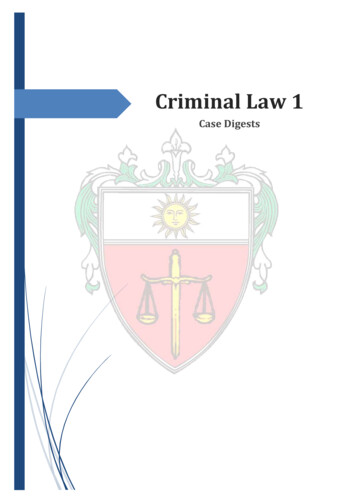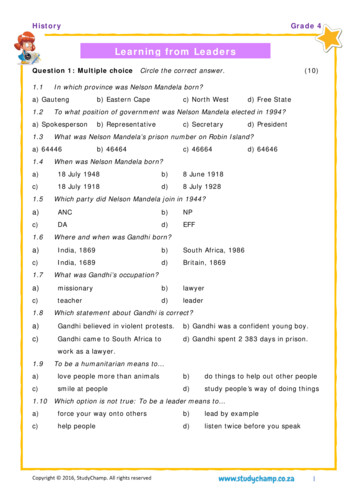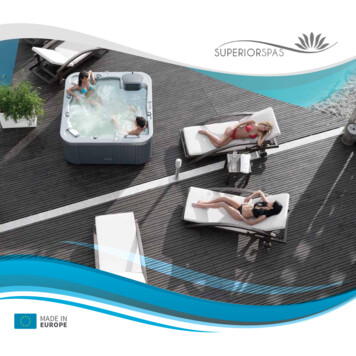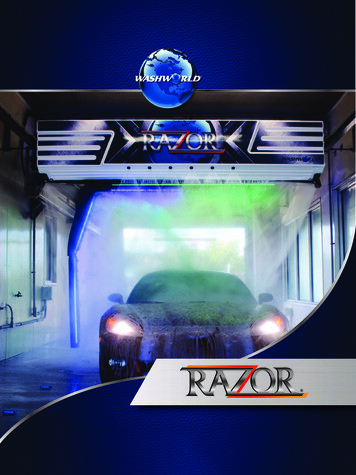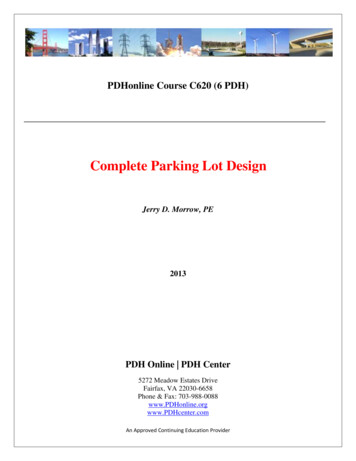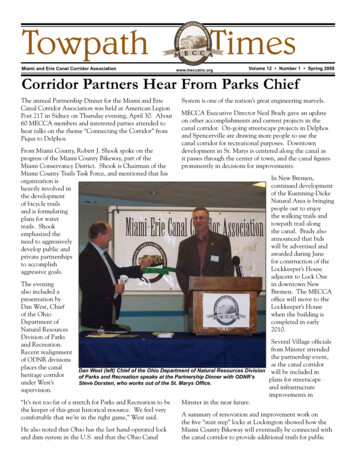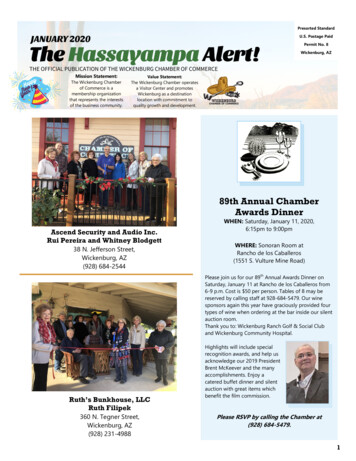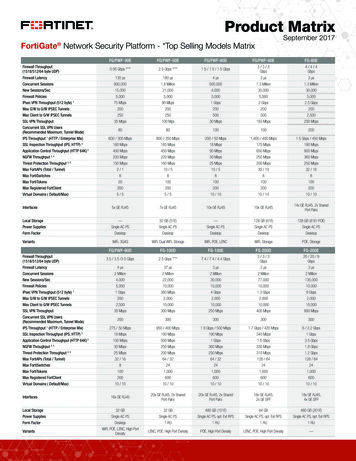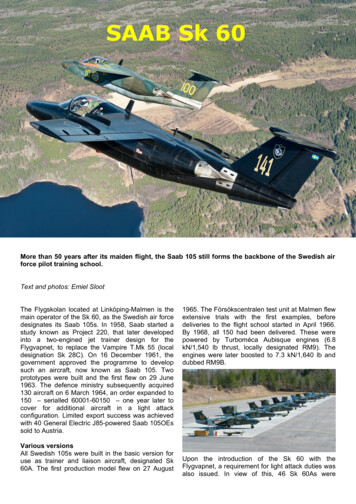
Transcription
SAAB Sk 60More than 50 years after its maiden flight, the Saab 105 still forms the backbone of the Swedish airforce pilot training school.Text and photos: Emiel SlootThe Flygskolan located at Linköping-Malmen is themain operator of the Sk 60, as the Swedish air forcedesignates its Saab 105s. In 1958, Saab started astudy known as Project 220, that later developedinto a two-engined jet trainer design for theFlygvapnet, to replace the Vampire T.Mk 55 (localdesignation Sk 28C). On 16 December 1961, thegovernment approved the programme to developsuch an aircraft, now known as Saab 105. Twoprototypes were built and the first flew on 29 June1963. The defence ministry subsequently acquired130 aircraft on 6 March 1964, an order expanded to150 – serialled 60001-60150 – one year later tocover for additional aircraft in a light attackconfiguration. Limited export success was achievedwith 40 General Electric J85-powered Saab 105OEssold to Austria.Various versionsAll Swedish 105s were built in the basic version foruse as trainer and liaison aircraft, designated Sk60A. The first production model flew on 27 August1965. The Försökscentralen test unit at Malmen flewextensive trials with the first examples, beforedeliveries to the flight school started in April 1966.By 1968, all 150 had been delivered. These werepowered by Turboméca Aubisque engines (6.8kN/1,540 lb thrust, locally designated RM9). Theengines were later boosted to 7.3 kN/1,640 lb anddubbed RM9B.Upon the introduction of the Sk 60 with theFlygvapnet, a requirement for light attack duties wasalso issued. In view of this, 46 Sk 60As were
retrofitted at the air force’s central workshop atLinköping-Malmen with a Ferranti F-105 ISISweapons sight from 1970. On three hardpointsunderneath each wing, up to 12 Bofors 13.5-cmrockets could be carried for light attack andweapons training. These aircraft were designated Sk60B.The first Sk 60C (60010), being an A-model butconverted before delivery, made its first flight on 18January 1967. For this version, the nose wasstretched to house a Fairchild KB-18 photo ce, alongside S 35E recce Drakens.For close air support, the aircraft could be fitted withBofors rockets and two FFV/Matra SA-10 Aden 30mm cannon pods. Another 29 Amodels were converted similarlyat Malmen to Sk 60Cs.In 1976 and 1977, another threeSk 60As were modified atMalmen, this time to Sk 60Dtransport and liaison aircraft thatwere fitted with civilian-styleavionicsandinstrumentscalibrated in feet and knots(rather than metres/kmh, thatwas the standard within theFlygvapnet, until the introductionof the JAS 39C Gripen). Asecond VOR/DME and ADFreceiver was installed as well asa transponder with altitudereporting, while the ejectionseats were replaced by fixedseats. The Sk 60D made its firstflight on 2 March 1977. In thisconfiguration, they were usedfor VIP and liaison flights withinthe country and abroad, andoperatedmainlyoutofStockholm-Bromma.During 1979 and 1980, 10 morewere converted similarly to Sk60E navigation trainers. Theseaircraft were used primarily bythe Trafikflygarhögskolan atLjungbyhed to train commercialpilots,whosimultaneouslybecame air force reserveofficers. Both the Sk 60D and -Ewere retired in 1999 and 2001,respectively.New enginesBetween 1988 and 1991, the142 remaining aircraft werestructurally overhauled includingfitting new wings. Following acontract signed on 4 November1993, Saab Aircraft conducted a re-engineprogramme between 1994 and 1998, in whichairframes exchanged their RM9B Aubisque enginesfor Williams-Rolls Royce FJ44-1A power plants(RM15). The new engines, digitally controlled by aFADEC (Full Authority Digital Engine Control)delivered 15 percent more thrust (8.45 kN/1,900 lbeach). Additional benefits were less weight thuslower fuel consumption, improving the range from1,900 km (1,026 NM) to 2,550 km (1,377 NM), andlower maintenance costs. The new engines werebuilt in at Ljungbyhed air base, while the air intakeshad to be slightly modified at the Saab factory inLinköping.
The first aircraft (60072) flew in August 1995. Theoriginal contract covered 115 aircraft (A, B and Cmodels), but for budgetary reasons this number waslater decreased to 106. Redeliveries started inSeptember 1996. In 1999, some re-engined aircraftencountered problems due to the higher enginebleed air pressure towards the air conditioningpacks, even causing a few pack turbine explosions,making additional modifications necessary.Swedish serviceWhen the Sk 60 entered service, it mainly equippedthe Flygskolan at Ljungbyhed, also known as F5Wing. Initially, new pilots graduated on the Sk 50Safir (later Sk 61 Bulldog) before moving on to theSk 60A for further training. As of 1987, new pilotsstart training directly on the Sk 60. Advanced tacticaltraining was then conducted with F20 Wing atUppsala, equipped with a mix of Sk 60B and -Caircraft.Beside the mentioned units, some Sk 60Bs and -Csequipped the 3rd Division of F21 Wing at LuleåKallax from 1973. After this unit disbanded in 1982,these aircraft transferred to F20, that soon becamepart of F16 at the same base, using these aircraft inthe same training role.The three four-seat Sk 60D aircraft for VIP flightsand liaison in view of the air force staff in Stockholmwere initially operated by F18 at Tullinge, but latertransferred to F16, although the aircraft mainlyoperated out of Stockholm-Bromma. The variousoperational fighter wings of the Swedish air forceoperated a handful of Sk60s each for their liaisonflights.FlygskolanThe Swedish air force flying training school or F5Wing had been based at Ljungbyhed in southernSweden since 1925, until the base closed in late1996. The Flygskolan subsequently moved tonearby Ängelholm, where it integrated within F10Wing. However, F10 was selected to disband a fewyears later, in December 2002, thus the HQ decidedin 2001 to move the school again, this time to itspresent home base Linköping-Malmen. Due toreconstruction works there, the school firsttemporarily relocated to Uppsala, where the tacticalpart of the flying training was already based for afew decades. On 1 July 2003, the wandering aroundSweden came to an end, and operations fromMalmen started.The unit was temporarily under command of theRonneby-based F17 wing, until the latestreorganisation came into effect on 1 January 2006.As a result, the school is now controlled by theLuftstridsskolan (LSS – Air Combat School) atUppsala, which is responsible for a number of otherair force training units as well as the test andevaluation units for the Gripen and the armed forces’helicopters, both also based at Malmen.Today, the Flygskolan consists of four units. Newpilots selected for flying training start their practicaleducation with the 1. Division (1st squadron), alsoknown as the Grundläggande Flyg Utbildning (GFU– Basic Flying Training). Its syllabus comprises 125flying hours including 39 solo, and lasts for one year.Military training is then continued at the air forceacademy in Stockholm, whereafter trainees returnfor the second part of flying training with the 2.Division (2nd squadron) or Grundläggande TaktiskUtbildning (GTU – Basic Tactical Training). Thispart – previously undertaken by F20 and F16 Wings,respectively – lasts for another year and takes some145 flying hours including 55 solo. The graduatedpilots move to the JAS 39 Gripen OCU with F7 Wingat Såtenäs. Since 1995, new transport pilots alsojoin the Flygskolan for training (GFU and part of theGTU course) while new helicopters might in futurealso join the GFU, although a decision on this hasyet to be taken at the time of writing.A third unit is the Utbildnings Sektionen (EducationUnit), which handles the 14-week Flight InstructorCourses. Finally, the Team 60 flight demonstrationteam completes the Flygskolan.
Basically, the Flygskolan only used the Sk 60A and B for training while the longnosed Sk 60Cs werelargely detached to the transport and liaison flightsof the JAS 39 Gripen wings F7, F17 and F21.While the Sk 60 is basically equipped with two sideby-side ejection seats, these can be exchanged withfour fixed seats for liaison purposes. In thisconfiguration, limitations apply in view of maximumg-loads and flight manoeuvres (no aerobaticsallowed), while close formation flying is alsoprohibited.Remarkable training resultsThe pedagogic philosophy applied by the Flygskolanwas established in the 1970s and refined over theyears. It is significantly different compared to otherforeign military pilot training courses. New pilots whosuccessfully finished the tough selection processand initial military training at the academy, enter theGFU course without any previous flying experience.The training philosophy puts a high level ofresponsibility to the student pilots, aiming to makethem both self-confident and self-critical. In this light,a substantial part of the syllabus is performed solo,to improve the student’s airmanship. On the otherhand, the relation between instructors and studentpilots is kept at an open level and rather ‘horizontal’from an authority point of view, resulting indecreased student stress levels, as learning to fly isstressful enough by itself, according to thephilosophy.When a sortie is debriefed, the instructor andstudent first discuss the flight in the classroom,without grades noted in view of the results. Then,both write down their own thoughts on the particularmission independently into their own flight diaries. Atthe end of the week, both will join and compare theirnotes, to check if both opinions match on what wentgood and what could be improved.The approach has proven to be very successful, asover 90 pct of the initially selected pilots make it tocombat-ready level. Both the GFU and GTU courseshave a capacity to start a course of ten pilots eachyear.On 1 January 2009, the Flygskolan moved into anew building, adjacent to their new hangars andflightline. The building is designed according to thetraining philosophy, with open offices and a jointcoffee room for both instructors and trainees,although both groups have their own briefing ure, the armedforcesarecurrentlyinvestigating to move theFlygskolan once more, thistime to Såtenäs, to have itcolocated with the GripenOCU. The decision will haveto be made at political level.New maintenance contractOn 19 December 2008, theForsvarets Materielverk FMV(Swedish Defence MaterialCommand) signed a contractworth SEK 900 million withSaab Aerotech, in which thiscompanywillundertakemaintenance for the wholeremaining Sk 60 fleet (then80 aircraft) from 2009 till 2017. The contractcontained options for additional flying hours andextension beyond 2017. Line maintenance is doneat the home bases of the F7, F17 and F21 wings,and the Flygskolan. Other inspections and overhaulwould be carried out at the maintenance facilities inLjungbyhed and Nyköping. Saab Aerotech alsoprovided spare parts and would cooperate withWilliams in view of engine overhaul andmaintenance.Team 60Instructors of the Flygskolan form the Team 60demonstration team. In 1974, F5 wing had set up adisplay with two Sk 60s. One year later, two morewere added, and soon after, the formation wasexpanded to six aircraft with a first rehearsal inNovember 1975. Following approval of the Swedishair force commander early 1976, Team 60 (referringto the type designation) was officially established.The first demo was performed over Göteborg-Säveon 15 May 1976, and the first appearance abroadwas over Skrydstrup, Denmark in 1980. Since then,Team 60 visited several air shows outside Sweden.During the Royal International Air Tattoo (RIAT)1996 at RAF Fairford, the team won the Sir DouglasBader Trophy for the best overall flying display.
Unfortunately, no demos were flown during 1989and 1990 due to lack of pilots, while the 1999season was cancelled due to engine-relatedproblems. After that, the team was forced to displaywith four aircraft only due to pilot shortage but in2004, the team was back on full strength.Team 60 could put up three different displays,depending on the visibility and cloud base. SevenSk 60As have been sprayed in the Team 60'scolours (serialled 60033, 61, 62, 96, 98, 125, 139).A problem related to the FJ44 engines was that thediesel injected into the exhaust to create smoke didnot ignite, due to the lower exhaust temperature.The engine manufacturer did not allow for extensivemodifications, so to counter this, smoke pods filledwith TEXPAR 15 diesel fuel were attached undereach wing from 2001. In 2006, TEXPAR 22 wasintroduced supplying a more dense and lastingsmoke cloud.Budgetary problems forced the team’s grounding in2007. Since then, only few displays were flown.Also, the 2009 maintenance contract with Saab didnot provide for Team 60 in view of extra flying hoursand stress to these airframes.Avionics upgradeThe retirement in December 2012 of the firstgeneration Saab JAS 39A Gripens equipped withmetric-style flight instruments, highlighted the desireto adopt new avionics for the Sk 60 trainer aircraft inthe light of standardisation. In addition, theinstallation of more modern navigation devices wasconsidered as highly useful, as in previousmodification programmes, the cockpit interior hadbeen largely untouched.On 21 September 2009, the FMV awarded an orderworth SEK 130 million to Saab, to upgrade theinstruments in a limited number of aircraft. The list ofmandatory requirements presented by FMV coveredthe earlier mentioned feet and knots presentation onallinstrumentstoharmonise the air forcefleet; new radios positioningsystem(GPS); a g-warningsystem; and an aircraftparametric registrationsystem. An additionalwish-list with optionalrequirements was alsoforwarded,includinginstalling an autopilotwith at least basicfunctionssuchasheading and altitudehold,simulatedweapons for tacticaltraining, digital flightinstruments including amulti-function display (MFD) as well as a head-updisplay (HUD) and compatibility for night visiongoggles (NVG). Unfortunately, budget limitationscaused that none of these extras were implemented.Sk 60AUAs by contract, Saab did all the design work andinstallation of the new equipment. Avionics selectedand installed in the process are the LITEF LCR-100gyrocompass AHRS (Altitude and HeadingReference System); a Garmin 430W combined GPSnavigation and VHF communications set; a GarminG TX330D Mode S transponder; and a Catron CA1326 Audio panel. New flight instruments include aSandel SN3500 digital HSI (horizontal situationindicator), while the Swiss Thommen AG supplied 3in air data instruments including an AD32 altimeter(left seat), a 3A63 Altimeter (right seat), two 5C15Mach/airspeed indicators (left & right seat) and a4A16 vertical speed indicator. Audio tones at 5.5 and6 g warn the crew when approaching and reachingthe airframe g-limit, respectively.While the actual cockpit conversion was undertakenat both Malmen and Ljungbyhed air bases, initialtesting was carried out from Saab's Linköping site.For follow-up flight testing and evaluation, Sk 60B60048 was used for the first test phase, basicallycovering the whole upgrade project. Thereafter, Sk60A 60079 was allocated to the second test phase,
addressing some issues that arose in the process.Both aircraft were operated by the FMV's Malmenbased unit.An initial operational capability date was set at 1July 2012. Exactly one year later, the Flygskolanreached full operational capability on the type.Thereafter, the base flights at the air force's threeGripen wings F7, F17 and F21 changed their aircraftfor modified ones.Beside the two test and trials aircraft, a total of 35Sk 60A/B were fitted with the new systems,unofficially dubbed Sk 60AU (Avionics Upgrade).Three more kits have been bought for possiblefuture use. Principally, the Sk 60AU is not a newversion, but rather a change to existing ones. Thisapproach made the certification process far lesscomplicated.The modification programme was completed mid2014. As a result, all unmodified aircraft includingthe few remaining Sk 60Cs were disposed of. Anumber of the surplus aircraft were kept stored atLjungbyhed.Operational useSoon after the introduction of the Sk 60AU, twoparticular downsides came to light. The LCR-100gyro initially operated in a mode unsuitable for theaircraft's performance. Operation of the gyro in amore advanced mode fixed this. Another issueinvolved the GPS. Since its antenna is located ontop, the signal is lost quite easily when doing certainmanoeuvres. Subsequently, it takes minutes toregain a valid GPS-position. A software updatesuccessfully solved this problem.During April 2014, Flygskolan’s GTU took the Sk60AU up for live firing of Bofors 13.5-cm rockets, apractice that had not been carried out for a numberof years. Unfortunately, after firing some ten rockets,the FMV discovered that the maintenance of theseweapons had not been carried out according toprotocol, so the exercise was halted. It is unclear ifsuch practices will be continued in the future.Night flying is a part of the syllabus that isexclusively carried out by the GTU. During thewinter season, each student accumulates 10 hoursof night navigation, instrument approaches andtouch-and-goes, covering 10 sorties. Night flying iscarried out on Tuesdays only, from November toFebruary. The Sk 60AU's cockpit has not beenmade compatible for night vision systems, sostudents will not master this until the Gripen course.ReplacementFitted with the new systems, the Sk 60AU is againsuited to be of good use in the Swedish fighter pilottraining programme. Still, while proved strong,reliable and well maintained, the airframes havealready reached a distinctive age. Replacement willbe necessary in the not-too-distant future. Variousvariants have already been studied for several yearsnow, ranging from buying a new training system likethe Pilatus PC-21, combining efforts with one ormore other nations such as Finland, to joining aninternational flight training centre abroad. A finaldecision has yet to be taken, and with the latestavionics upgrade, the Swedish military bought someadditional time to consider its options. Sk 60 serials in Swedish air force serviceSk 60A:Sk 60B:Sk 60C:Sk 60D:Sk 60E:60001-60150 (Sk 60B-E are all conversions from A-models, except for 60010 thatwas already converted to Sk 60C before delivery)60034-60039, 60041-60042, 60044-60046, 60048-60050, 60052,60054-60060, 60063-60077, 60080, 60082-60083,60085-60087, 60089-6009160001-60007, 60009-60028, 60030-6003260097, 60131-6013260140, 60142-60150Aircraft that received the avionics upgrade (“Sk 60AU”) are:60033, 60036*, 60038*, 60040, 60041*, 60045*, 60048*, 60058*, 60061, 60062, 60063*, 60073*, 60079,60083*, 60086*, 60088, 60096, 60098, 60100, 60101, 60104, 60105, 60109, 60112, 60114, 60115, 60116,60118, 60123, 60125, 60126, 60129, 60133, 60136, 60137, 60139 & 60141(* Sk 60B)
This article, as well as parts of it, have been published in various aviation magazines such as CombatAircraft (UK – Vol.12 No.2), Ptisi (Greece – No.298) and Aranysas (Hungary – Mar2007). Furthermore,images have been used for various purposes, including a Saab 105 book published by the Swedish AviationHistorical Society.A separate article was completed on Team 60. 2014
More than 50 years after its maiden flight, the Saab 105 still forms the backbone of the Swedish air force pilot training school. Text and photos: Emiel Sloot The Flygskolan located at Linköping-Malmen is the main operator of the Sk 60, as the Swedish ai
